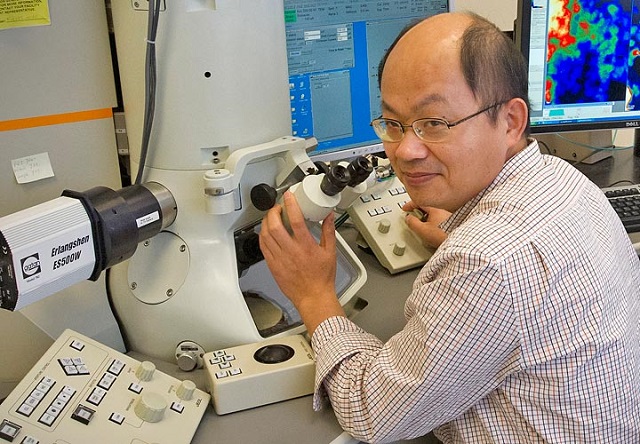 Brookhaven Lab scientist Feng Wang of Brookhaven Lab's Sustainable Energy Technologies Department, who will lead the collaboration with Zhang's team at CFN.
Brookhaven Lab scientist Feng Wang of Brookhaven Lab's Sustainable Energy Technologies Department, who will lead the collaboration with Zhang's team at CFN.
Toyota is collaborating with the Brookhaven National Laboratory of the U.S. Department of Energy to explore the molecular structure and monitor chemical reactions in rechargeable magnesium batteries.
Mg batteries are considered as an ideal candidate for replacing the existing Li ion batteries due to the abundance of Mg and its greater storage capacity. Lithium ion batteries have a lot of limitations in cost, durability and energy density and are not ideal for large-scale uses such as in electric or hybrid vehicles.
Scientists from Toyota will partner with researchers from the Brookhaven lab and use sophisticated observational and analytical instruments such as the high-resolution transmission electron microscopy and electron energy loss spectroscopy in the lab to study the atomic morphologies and real-time electrochemical reactions in Mg-based batteries.
Toyota’s research goals are a perfect match for our expertise in tracking the real-time chemical reactions of cutting-edge materials.
J. Patrick Looney, Chair of Brookhaven Lab’s Sustainable Energy Technologies Department
The imaging capabilities at CFN enable tracking the reactions of magnesium at nanoscale resolution in real time. This highlights the origin of structural disorders and how they affect performance of the material. Magnesium ions can store more energy compared to Li ions as they have two times the intrinsic charge of lithium ions. However, the shuttling of Mg ions between the cathode and anode in each cycle results in degradation of the material.
A detailed study of the rates and patterns of degradation would enable a clear understanding of the degradation mechanisms. Once the mechanism is clear, scientists can customize the atomic structures of compounds so as to enhance battery life while optimizing battery performance.
Toyota researchers intend to study the chemistry of a magnesium cathode made up of fullerenes, which are hollow carbon molecules. Fullerenes stay intact even after several charge and discharge cycles and thus deliver consistent energy, very low voltage hysteresis, and a quicker cycling rate. However, battery integration and performance is still a challenge and a complete understanding of the crystallization mechanisms, structural evolution, and other factors affecting the electrochemical reactions is the need of the hour.
The lab also houses the highly advanced x-ray light source facility, the National Synchrotron Light Source II, which will start functioning in 2015. This light source can achieve single-nanometer resolution and aid very advanced energy research. Overcoming the limitations of magnesium batteries will open up a whole new world of possibilities in multivalent batteries using cadmium or aluminum, thereby taking battery technology to the next level.
References